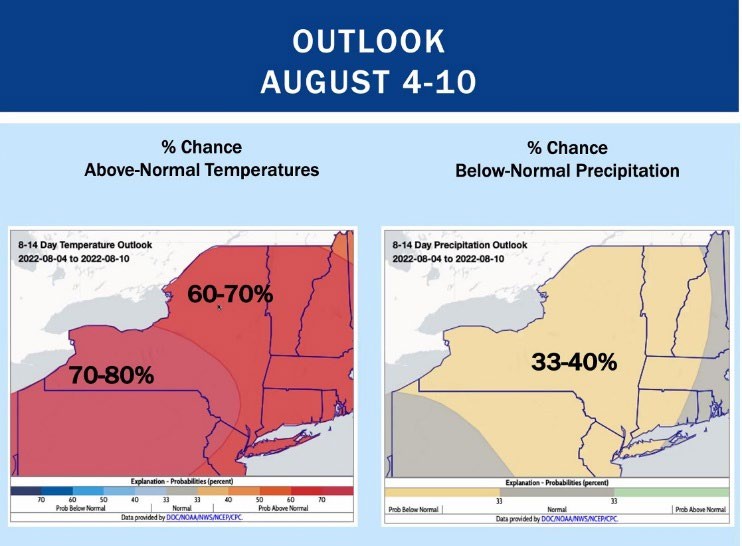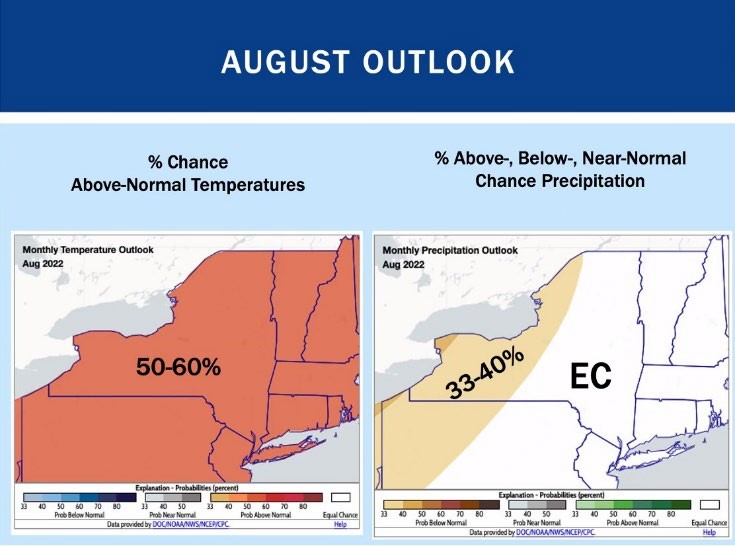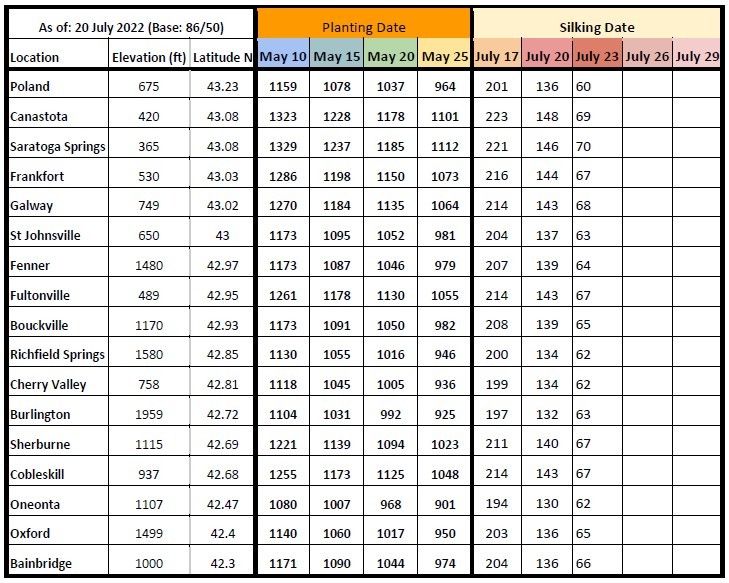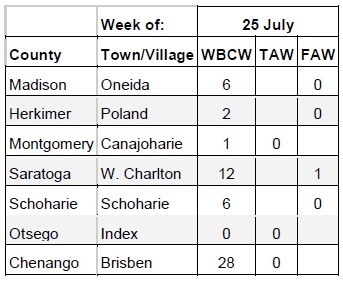Field Crop Update July 27, 2022
Erik Smith, Area Field Crop Specialist
Central New York Dairy and Field Crops
1. Field Observations
All of the corn fields where I have pheromone traps have tasseled within the last 7-9 days. There are a few late plantings that have yet to tassel. Soybean canopy is closing, but other than the usual Japanese beetles and grasshoppers that descend this time of year, I haven't seen many pests as of yet. A few aphids and leafhoppers here and there, but lots of ladybugs and other predators.
Hay production is suffering this year, so consider a triticale winter cover crop that you can use for baleage in spring: Winter Triticale - A Cropping Opportunity
Conditions were very dry until our recent rainstorms, but the outlook isn't very favorable. Very hot and likely dry through August (see figures below).
Drought-stressed corn that experiences high temps late in the season can actually have delayed dry-down according to Joe Lawrence of Dairy One. So while our Growing Degree Day predictions are a good first-step - and they will dictate whether harvest will be relatively early or late - be sure to check dry matters to make sure you're on target.
See these articles for more info:
Corn Silage 2019: 2 Different Crops
Wet Corn Silage Can Be an Environmental Challenge


2. Growing Degree Days as of July 20 (See: Climate Smart Farming Growing Degree Day Calculator)
Growing degree days (GDD) are calculated by taking the average daily temperature and subtracting the base temperature for development of a given organism ((High + Low)/2 - base temp = GDD). For corn silage, we are using base 50/86, as corn development starts at 50 degrees F and ceases above 86. Check your location and planting date:

3. Pest & Disease Monitoring
A. Western bean cutworm (WBCW), true armyworm (TAW) and fall armyworm (FAW) in corn.
This week, insect numbers increased slightly, but remained low. At tasseling, the window of risk for WBCW largely closes, and the cornfields where we saw the highest populations (still very low by damage-causing standards) tasseled last week and there were no egg masses in sight:

B. Potato leafhopper in alfalfa.
Monday's rain got in the way of my sweeping schedule this week, but almost all of my usual fields were either just cut last week, or are due to be cut imminently. So we will check back in with those locations next week:

Field Crop Update July 27, 2022 (pdf; 448KB)
Upcoming Events
New York State Fiber Conference
June 9, 2024
Bouckville, NY
Theme for this year: Quality Matters
Announcements
Cash Rent and Custom Harvest Survey
To date, there is limited information available about rental rates and fees for crop harvesting. Farms can use this valuable information for their farm business planning to help improve decision making and profitability.Farmers Can Join MeatSuite For Free!
MeatSuite.com is a free resource provided by Cornell University where NY meat farmers can create a farm profile and list their bulk (wholes, halves, quarters) and bundled (i.e. Grilling Bundle) meat products.Why should farmers join?
1. It's free and easy!
2. Connect with more local customers. In the past year the MeatSuite.com farm directory had 8,300 visits from New York consumers. Farm profiles get as many as 25 views per month from potential local customers. We also spotlight MeatSuite farms on social media and bring attention and purchases to farms through highlights and giveaways.
How do I join?
Farmers can visit https://www.meatsuite.com/farmers/ to create a free farm profile. You must list at least one product for your farm's profile to go live. You'll also have access to Cornell's free Meat Price Calculator, a helpful tool for pricing your meat to make a profit.
While you're on MeatSuite, check out the "Creating Consumer-Friendly Bulk Meats" publication on the log-in page. It has tips on how to create bulk meat products that are easier for first-time buyers to say "yes" to.
If you have any questions as you create your farm profile or products, we're here to help! Please email Matt LeRoux at mnl28@cornell.edu.




